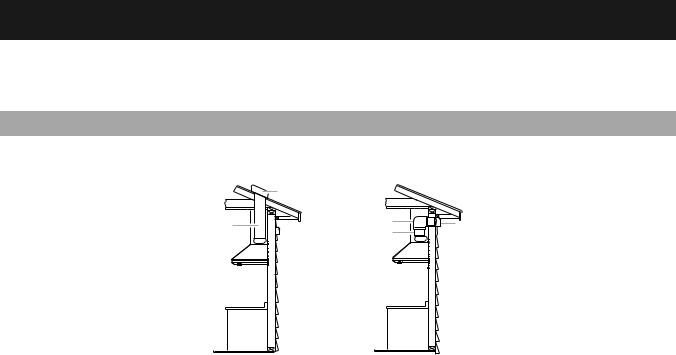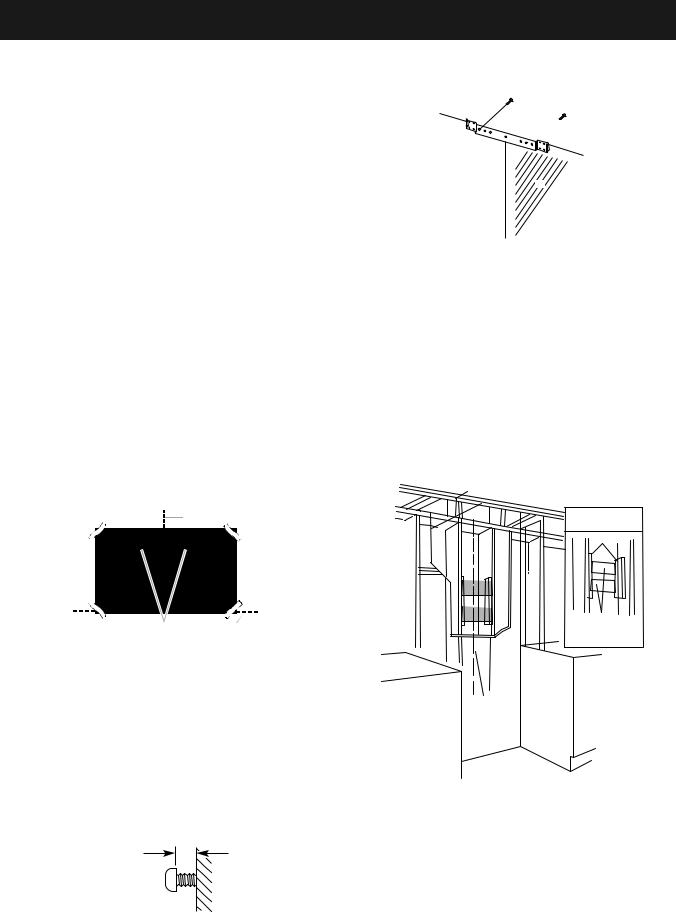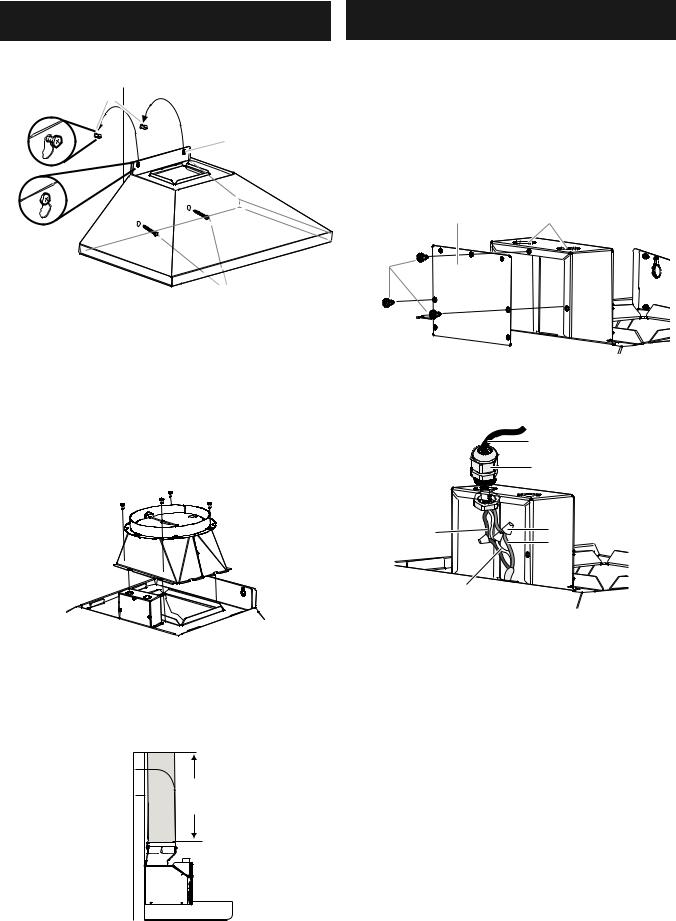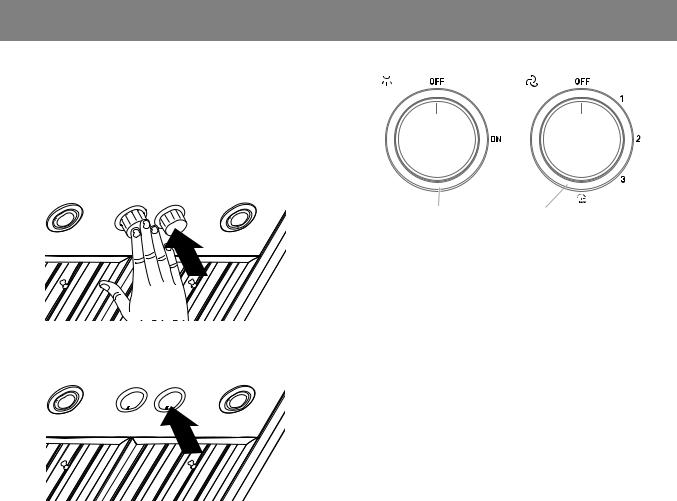Elica ELN136S2 Installation manual

Models: ELN630S2 ELN136S2 ELN142S2 ELN148SS
Use, Care, and
Installation Guide
Guide d’utilisation, d’entretien et d’installation
Guía de instalación, uso y mantenimiento
READ AND SAVE THESE
INSTRUCTIONS
LISEZ CES
INSTRUCTIONS ET
CONSERVEZ-LES
LEA Y CONSERVE ESTAS INSTRUCCIONES
LIB0138269A
Printed in Mexico
08/19
1
2

ENGLISH
Contents |
|
Important safety notice................................................................................................................................................................................................. |
4 |
Electrical & installation requirements ................................................................................................................................................................ |
5 |
Before installing the hood ...................................................................................................................................................................................... |
5 |
Product dimensions ....................................................................................................................................................................................................... |
5 |
List of materials................................................................................................................................................................................................................. |
6 |
Parts supplied .............................................................................................................................................................................................................. |
6 |
Parts not supplied ...................................................................................................................................................................................................... |
6 |
Ducting options and examples.................................................................................................................................................................................. |
7 |
Installation ......................................................................................................................................................................................................................... |
8 |
Electrical connection................................................................................................................................................................................................ |
9 |
Complete the installation........................................................................................................................................................................................ |
10 |
Description of the hood................................................................................................................................................................................................. |
10 |
Control.................................................................................................................................................................................................................................. |
11 |
Maintenance ...................................................................................................................................................................................................................... |
12 |
Warranty ........................................................................................................................................................................................................................... |
13 |
APPROVED FOR RESIDENTIAL APPLIANCES
FOR RESIDENTIAL USE ONLY
READ AND SAVE THESE INSTRUCTIONS
PLEASE READ ENTIRE INSTRUCTIONS BEFORE PROCEEDING.
INSTALLATION MUST COMPLY WITH ALL LOCAL CODES.
IMPORTANT: Save these Instructions for the Local Electrical Inspector’s use.
INSTALLER: Please leave these Instructions with this unit for the owner.
OWNER: Please retain these instructions for future reference.
Safety Warning: Turn off power circuit at service panel and lock out panel, before wiring this appliance. Requirement: 120 V AC, 60 Hz. 15 or 20 A Branch Circuit.
3

I IMPORTANT SAFETY NOTICE
I CAUTION
FOR GENERAL VENTILATING USE ONLY. DO NOT USE TO EXHAUST HAZARDOUS OR EXPLOSIVE MATERIALS OR VAPOURS.
IWARNING
TO REDUCE THE RISK OF A RANGE TOP GREASE FIRE.
a)Never leave surface units unattended at high settings. Boilovers cause smoking and greasy spillovers that may ignite. Heat oils slowly on low or medium settings.
IWARNING
TO REDUCE THE RISK OF FIRE, ELECTRIC SHOCK, OR INJURY TO PERSONS, OBSERVE THE FOLLOWING:
A.Use this unit only in the manner intended by the manufacturer. If you have questions, contact the manufacturer.
B.Before servicing or cleaning the unit, switch power off at service panel and lock service panel disconnecting means to prevent power from being switched on accidentally.
When the service disconnecting means cannot be locked, securely fasten a prominent warning device, such as a tag, to the service panel.
C.Installation work and electrical wiring must be done by qualified person(s) in accordance with all applicable codes & standards, including fire-rated construction.
D.Sufficient air is needed for proper combustion and exhausting of gases through the flue (Chimney) of fuel burning equipment to prevent backdrafting.
Follow the heating equipment manufacturers guideline and safety standards such as those published by the national fire protection association (NFPA), the american society for heating, refrigeration and air conditioning engineers (ASHRAE), and the local code authorities.
E.When cutting or drilling into wall or ceiling, do not damage electrical wiring and other hidden utilities.
F.Ducted systems must always be vented to the outdoors.
I CAUTION
To reduce risk of fire and to properly exhaust air, be sure to duct air outside - do not vent exhaust air into spaces within walls, ceilings, attics, crawl spaces, or garages.
IWARNING
TO REDUCE THE RISK OF FIRE, USE ONLY METAL DUCT WORK.
Install this hood in accordance with all requirements specified.
IWARNING
To reduce the risk of fire or electric shock, do not use this hood with any external solid state speed control device.
I WARNING
b)Always turn hood ON when cooking at high heat or when flambeing food (I.e. Crepes Suzette, Cherries Jubilee, Peppercorn Beef Flambe’).
c)Clean ventilating fans frequently. Grease should not be allowed to accumulate on fan or filter.
d)Use proper pan size. Always use cookware appropriate for the size of the surface element.
IWARNING
TO REDUCE THE RISK OF INJURY TO PERSONS, IN THE EVENT OF A RANGE TOP GREASE FIRE, OBSERVE THE FOLLOWING:a
a)SMOTHER FLAMES with a close-fitting lid, cookie sheet, or other metal tray, then turn off the gas burner or the electric element. BE CAREFUL TO PREVENT BURNS. If the flames do not go out immediately, EVACUATE AND CALL THE FIRE DEPARTMENT.
b)NEVER PICK UP A FLAMING PAN - you may be burned.
c)DO NOT USE WATER, including wet dishcloths or towels - a violent steam explosion will result.
d)Use an extinguisher ONLY if:
1)You know you have a class ABC extinguisher, and you already know how to operate it.
2)The fire is small and contained in the area where it started.
3)The fire department is being called.
4)You can fight the fire with your back to an exit.
e)Ducted fans must always be vented to the outdoor.
aBased on “Kitchen Fire Safety Tips” published by NFPA.
I CAUTION
Automatically Operated Device - To reduce the risk of Injury disconnect from power supply before servicing.
To Reduce The Risk Of Fire And Electric Shock, Install This Rangehood Only With Integral, In Line, and External Blower Models Rated Maximum 7.6 A/ 913 W Or Integral Blowers Manufactured by Elica (for model references, see optional accessories table).
|
|
Integral Blower |
|
|
In Line |
|
External |
|||||
|
|
(already included |
|
Blower Kit 1200 |
|
Blower Kit 1200 |
||||||
|
|
with the hood) |
|
KIT0154387 |
|
KIT0153054 |
||||||
HOOD MODEL |
|
A |
|
W |
|
A |
|
W |
|
A |
|
W |
|
|
|
|
|
|
|||||||
ELN630S2 |
|
3.9 |
|
463 |
|
7.65 |
|
453.9 |
|
7.42 |
|
884 |
|
|
|
|
|
|
|
|
|
|
|
|
|
ELN136S2 |
|
7.6 |
|
913 |
|
7.6 |
|
913 |
|
7.37 |
|
884 |
|
|
|
|
|
|
|
|
|
|
|
|
|
ELN142S2 |
|
7.6 |
|
913 |
|
7.6 |
|
913 |
|
7.37 |
|
884 |
|
|
|
|
|
|
|
|
|
|
|
|
|
ELN148SS |
|
7.6 |
|
913 |
|
7.6 |
|
913 |
|
7.37 |
|
884 |
|
|
|
|
|
|
|
|
|
|
|
|
|
4

ELECTRICAL & INSTALLATION REQUIREMENTS
IMPORTANT
Observe all governing codes and ordinances.
It is the customer’s responsibility:
•To contact a qualified electrical installer.
•To assure that the electrical installation is adequate and in conformance with National Electrical Code, ANSI/NFPA 70
— latest edition*, or CSA Standards C22.1-94, Canadian Electrical Code, Part 1 and C22.2 No.0-M91-latest edition** and all local codes and ordinances.
•If codes permit and a separate ground wire is used, it is recommended that a qualified electrician determine that the ground path is adequate.
•Do not ground to a gas pipe.
•Check with a qualified electrician if you are not sure range hood is properly grounded.
•Do not have a fuse in the neutral or ground circuit.
IMPORTANT
•Save Installation Instructions for electrical inspector’s use.
•The range hood must be connected with copper wire only.
•The range hood should be connected directly to the fused disconnect (Or circuit breaker) box through metal electrical conduit.
•Wire sizes must conform to the requirements of the National Electrical Code ANSI/NFPA 70 — latest edition*, or CSA Standards C22.1-94, Canadian Electrical Code Part 1 and C22.2 No. 0-M91 - latest edition** and all local codes and ordinances.
•A U.L.- or C.S.A.-listed conduit connector must be provided at each end of the power supply conduit (at the range hood and at the junction box).
Copies of the standards listed may be obtained from:
*National Fire Protection Association Batterymarch Park Quincy, Massachusetts 02269
**CSA International 8501 East Pleasant Valley Road Cleveland, Ohio 44131-5575
BEFORE INSTALLING THE HOOD
1For the most efficient air flow exhaust, use a straight run or as few elbows as possible.
CAUTION: Vent unit to outside of building, only.
2At least two people are necessary for installation.
3Fittings material is provided to secure the hood to most types of walls/ceilings, consult a Qualified Installer, check if they perfectly fit with your cabinet/wall.
4Do not use flex ducting.
5COLD WEATHER installations should have an additional backdraft damper installed to minimize backward cold air flow and a nonmetallic thermal break to minimize conduction of outside temperatures as part of the ductwork. The damper should be on the cold air side of the thermal break.
The break should be as close as possible to where the ducting enters the heated portion of the house.
6Make up air: Local building codes may require the use of Make-Up Air Systems when using Ducted Ventilation Systems greater than specified CFM of air movement. The specified CFM varies from locale to locale. Consult your HVAC professional for specific requirements in your area.
PRODUCT DIMENSIONS
F |
G |
|
Models |
|
|
|
|
|
|||
|
|
ELN630S2 |
ELN136S2 |
ELN142S2 |
ELN148SS |
E |
|
A 30” (76.2 cm) |
36” (91.4 cm) |
42” (106.7 cm) |
48” (122 cm) |
|
|
B |
24” (61 cm) |
|
|
|
|
C |
Max: 47 5⁄8” (120.9 cm) |
|
|
|
C |
|
Min: 30” (76.2 cm) |
|
|
|
|
|
|
|
|
|
D* |
D* |
Max: 84” (213.5 cm) |
|
|
|
|
Min: 51 1⁄4” (130.2 cm) |
|
||
|
|
|
|
||
|
|
E |
13 2⁄16” (33.2 cm) |
|
|
|
|
F |
10 5⁄8” (27 cm) |
|
|
|
|
G |
8” (20.3 cm) |
|
|
A
* with Long Chimney Extension Kit
B
5

LIST OF MATERIALS
Removing the packaging.
I CAUTION
Remove carton carefully, Wear gloves to protect against sharp edges.
I WARNING
Remove the protective film covering the product before putting into operation.
Supplied Part |
Pieces |
1
Hood assembly and
LED lamps already installed
 6 5x45 mm
6 5x45 mm
5.4x75 mm |
4 |
|
|
3.5x9.5 mm |
4 |
|
|
4.2x8 mm |
4 |
|
|
Torx 20 adapter |
1 |
|
Supplied Part |
Pieces |
2
Duct covers
1
8” round air transition
 2 8x40 mm
2 8x40 mm
1
Duct cover bracket
1
Mounting template
|
Parts no supplied |
|
|||
|
|
|
|
|
|
Tools/Materials required |
Parts needed |
|
|||
• Level |
• Home power supply cable |
|
|||
• Drill |
• 1 - ½” (12.7 mm) UL listed or CSA approved strain relief |
||||
• 11⁄4” (3.2 cm), 1⁄8” (3.2 mm), and 1⁄16” (4.8 mm) drill bits |
• 3 UL listed wire connectors |
|
|||
• Pencil |
|
||||
• 1 wall or roof cap |
|
||||
• Wire stripper or utility knife |
|
||||
• Metal vent system |
|
||||
• Tape measure or ruler |
|
||||
|
|
|
|
||
• Pliers |
Optional accessories and consumable parts |
||||
• Caulking gun and weatherproof caulking compound |
|||||
|
|
|
|
||
• Jigsaw or keyhole saw |
|
KIT |
# Part |
||
• Metal snips |
|
||||
|
|
|
|
||
|
|
|
|
||
• Screwdrivers: |
|
Long Chimney |
|
KIT02785 |
|
- Flat-blade |
|
Extension |
|
||
|
|
|
|||
- Phillips |
|
|
|
|
|
|
in Line Blower |
|
|
||
- Torx 10 |
|
|
KIT0154387 |
||
|
1200 Kit |
|
|||
|
|
|
|
||
|
|
|
|
|
|
|
|
External Blower |
|
KIT0153054 |
|
|
|
1200 Kit |
|
||
|
|
|
|
||
|
|
|
|
|
|
6

Ducting options
Closely follow the instructions set out in this manual.
All responsability, for any eventual inconveniences, damages or fires caused by not complying with the instructions in this manual, is declined.
Ducting version
The hood is equipped with an 8” (20.3 cm) round transition for discharge of fumes to the outside.
Roof Venting |
Wall Venting |
A |
|
B |
C |
A |
|
|
B |
A. |
Roof cap |
A. |
Wall cap |
B. |
8” (20.3 cm) round vent |
B. |
8” (20.3 cm) round vent |
Preparation
Do not cut a joist or stud unless absolutely necessary. If a joist or stud must be cut, then a supporting frame must be constructed.
Fittings material is provided to secure the hood to most types of walls/ceilings.
However, a qualified technician must verify suitability of the materials in accordance with the type of wall/ceiling. Before making cutouts, make sure there is proper clearance within the ceiling or wall for exhaust vent.
Recommended installation height:
Hood installation height above cooktop is the users preference. The lower the hood is above the cooktop, the more efficient the capturing of cooking odors, grease and smoke.
I CAUTION
For gas cooktop & range installations: Mount the hood so the bottom is at least 30” (76.2 cm) above the cooking surface. For electric/induction cooktop & range installations: Mount the hood so the bottom is at least 24” (61 cm) above the cooking surface.
There is no maximum mounting height, however, we recommend mounting the hood no greater than 36” (91.4 cm) above the cooking surface. For every inch (2.54 cm) above 36” (91.4 cm), fume and moisture capture efficiency diminishes at an increasing rate and may not deliver an acceptable level of ventilating performance.
This hood is intended for household use.
PLEASE READ THE INSTALLATION MANUAL FOR SPECIFIC APPLICATION. Check your ceiling height and hood height before selecting your hood.
7

Installation
Prepare location
•It is recommended that the vent system be installed before hood is installed.
•Before making cutouts, make sure there is proper clearance within the ceiling or wall for exhaust vent.
•Check your ceiling height and the hood height maximum before you select your hood.
1Disconnect power.
2Determine which venting method to use: roof, wall, or nonvented.
3Select a flat surface for assembling the range hood. Place covering over that surface.
I WARNING
TO REDUCE THE RISK OF FIRE, ELECTRIC SHOCK, OR INJURY TO PERSONS, OBSERVE THE FOLLOWING.
4Using 2 or more people, lift range hood onto covered surface.
Mounting the duct cover bracket
1Determine and mark the centerline on the wall where the canopy hood will be installed. Disconnect power.
2Select a mounting height between a minimum of 24” (61 cm) for an electric cooking surface, a minimum of
30” (76.2 cm) for a gas cooking surface, and a suggested maximum of 36” (91.4 cm) above the range to the bottom of the hood.
Mark a reference line on the wall.
3Tape template in place, aligning the template centerline and bottom of template with hood bottom line and with the centerline marked on the wall.
A
C
B
A.Centerline
B.Fastener locations
C.Mounting height reference (hood bottom line)
4Mark centers of the fastener locations through the template to the wall.
IMPORTANT: All screws must be installed into wood.
If there is no wood to screw into, additional wall framing supports may be required.
5Remove the template.
6Drill 3⁄16” (4.8 mm) pilot holes at all locations where screws are being installed into wood.
7Install the 2 - 5 x 45 mm mounting screws. Leave a 1⁄4” (6.4 mm) gap between the wall and the back of the screw head to slide range hood into place.
1⁄4”
(6.4 mm)
Vent cover bracket installation
1Attach vent cover bracket to wall flush to the ceiling using 2 - 5 x 45 mm screws.
 A
A
B
C
A.Ceiling
B.Wall
C.Centerline
Install framing for hood support
•If drywall is present, mark the screw hole locations.
•Cut away enough drywall to expose 2 vertical studs at the holes location indicated by the template.
Install two horizontal supports at least 4 x 2” between two wall studs at the bottom and upper mounting holes installation location.
•The horizontal support must be flush with the room side of the studs.
•Use cleats behind both sides of the support to secure to wall studs.
•Reinstalll drywall and refinish
IMPORTANTFraming must be capable of supporting 100 lbs.
8½” min. opening for ductwork
View from rear cleats
1” x 6” min Mounting Support
Centerline of installation space
Complete preparation
1Determine and make all necessary cuts in the wall for the vent system. Install the vent system before installing the hood. See “Venting Requirements” section.
2Determine the required height for the home power supply cable and drill a 1¼” (3.2 cm) hole at this location.
3Run the home power supply cable according to the
National Electrical Code or CSA Standards and local codes and ordinances. There must be enough ½” conduit and wires from the fused disconnect (or circuit breaker) box to make the connection in the hood’s electrical terminal box.
NOTE: Do not reconnect power until installation is complete. 4 Use caulk to seal all openings.
8

Install range hood
1Using 2 or more people, hang range hood on 2 mounting screws through the mounting slots on back of hood.
A
B
C
A. Mounting screws
B. Mounting slots
C. Lower mounting screws
1
2Mark with a pencil the lower mounting holes location.
3Uninstall the hood assembly, and drill 3⁄16” (4.8 mm) pilot holes at marked locations.
4Hang the range hood again on 2 upper mounting screws.
5Level the range hood and tighten upper mounting screws.
6Install 2 - 5 x 45 mm lower mounting screws and tighten. Use the optional wall anchors if needed.
Connect vent system
1Install transition on top of hood (if removed for shipping) with 2 - 3.5 x 9.5 mm sheet metal screws.
A.Vent transition
B.3.5 x 9.5 mm screw
For vented installations only:
1Fit vent system over the exhaust outlet.
2Measure from the bottom of the air deflector to the bottom of the hood outlet. Cut the ductwork at the measured dimension.
Roof outlet
Wall
outlet
Dimension to measure
3Seal connection with clamps.
4Check that back draft dampers work properly.
Electrical connection
I WARNING
ELECTRICAL SHOCK HAZARD.
I WARNING
DISCONNECT POWER BEFORE SERVICING.
REPLACE ALL PARTS AND PANELS BEFORE OPERATING. FAILURE TO DO SO CAN RESULT IN DEATH OR ELECTRICAL SHOCK.
1Disconnect power.
2Remove terminal box cover.
3Remove the knockout in the terminal box cover and install a UL listed or CSA approved 1⁄2” strain relief.
B A
C
A.Knockout
B. Junction box cover
C. Junction box cover screws
4Run home power supply cable through strain relief, into terminal box.
|
E |
|
F |
B |
C |
|
|
|
D |
|
A |
A.White wires |
D. Green, Bare or Yellow/Green wires |
B. Black wires |
E. Home power supply |
C. UL listed wire connectors |
F. UL listed or CSA approved ½” strain |
|
relief |
5Use UL listed wire connectors and connect black wires
(C) together.
6Use UL listed wire connectors and connect white wires (E) together.
I WARNING
ELECTRICAL SHOCK HAZARD.
I WARNING
ELECTRICALLY GROUND BLOWER.
CONNECT GROUND WIRE TO GREEN AND YELLOW GROUND WIRE IN TERMINAL BOX. FAILURE TO DO SO CAN RESULT IN DEATH OR ELECTRICAL SHOCK.
7Connect green (or bare) ground wire from home power supply to yellow-green ground wire (F) in terminal box using UL listed wire connectors.
8Tighten strain relief screw.
9Install terminal box cover.
10Check that all light bulbs are secure in their sockets.
11Reconnect power.
9

Install duct covers
•When using both upper and lower vent covers, push lower cover down onto hood and lift upper cover to ceiling and install with two mounting screws.
NOTE: For vented installations, the upper vent cover may be reversed to hide slots.
Complete installation
•Install metal filters. See the “Mainteinance” section.
To get the most efficient use from your new range hood, read the “maintenance” section.
Keep your Use, Care, and installation Guide close to range hood for easy reference.
Description of the hood
•Secure the bottom of the duct with 2 - 4 x 8 mm screws.
5
1
2
3
4
1.Blower and light controls
2.LED lamps
3.Grease filter
4.Grease filter handle
5.Duct covers
10

Control
The range hood is designed to remove smoke, cooking vapors and odors from the cooktop area. For best results, start the hood before cooking and allow it to operate several minutes after the cooking is complete to clear all smoke and odors from the kitchen.
The hood controls are located on the center side of the hood.
Recessing Knobs
•You can hide control knobs by depressing them until flush with the hood body.
•Pressing the knobs again will lower the knobs, and enable the user to operate the lights and blower.
Controls
AB 
A.Lamps knob
B.Blower knob
Operating the lamps
1.Turn the light switch to the “ON” position to turn the range hood lights On.
2.Turn the light switch to the “OFF” position to turn the range hood lights Off.
Operating the blower
1.Turn the blower switch at “1” to turn the range hood on.
2.Turn the blower switch to the desired speed position.
3.Turn the blower switch to the “MAX” position to turn the range hood on High.
4.Turn the blower switch to the “OFF” position to turn the range hood blower Off.
Auto On blower
The range hood is equipped with a sensor to automatically turn on the blower when excessive heat is detected in the control area. When the blower switch is in the “Off” position, this sensor will turn the blower to high speed when necessary. When the heat decreases, the blower will turn off. When the blower switch is in the On position, the heat sensor is not active and the range hood functions normally.
11
